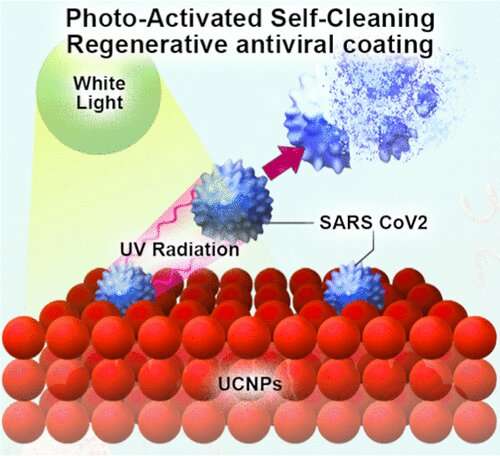
A team of UCF researchers have proven the efficacy of a nanomaterial-based disinfectant they developed to combat the spread of the COVID-19 virus. Through their experiments, they found that the disinfectant was able to kill several serious viruses including SARS and Zika. The results of their findings were recently published in ACS Applied Materials and Interfaces.
“It is always a delight to have our research work featured in a reputed journal,” said Udit Kumar, a doctoral student in the Department of Materials Science and Engineering (MSE) and the lead author of the journal article. “Given the theme and possible impact of antiviral research in current times, our article will definitely aid our fight against global pandemics.”
The paper outlines the most recent study from a multidisciplinary team of researchers that includes Sudipta Seal, the chair of the MSE department, and Griff Parks, a College of Medicine virologist and director of the Burnett School of Biomedical Sciences. They experimented with the nanomaterial yttrium silicate, which has antiviral properties that are activated by white light, such as sunlight or LED lights. As long as there is a continuous source of light, the antiviral properties regenerate, creating a self-cleaning surface disinfectant.
“Yttrium silicate acts as a silent killer, with antiviral properties constantly recharged by the light,” Kumar says. “It is most effective in minimizing surface to the surface spread of many viruses.”
Kumar says their test of yttrium silicate in white light disinfected surfaces with high viral loads in approximately 30 minutes. Additionally, the nanomaterial was able to combat the spread of other viruses including parainfluenza, vesicular stomatitis, rhinovirus, Zika and SARS.
“This disinfectant technology is an important achievement for both engineering and health because we all were affected during the pandemic,” Seal says. “COVID is still ongoing and who knows what other illnesses are on the horizon.”
Other UCF researchers, including College of Medicine postdoctoral researcher Candace Fox, nanotechnology student Balaashwin Babu and materials science and engineering student Erik Marcelo, are co-authors on the paper.
“This publication is the culmination of timely insight by the investigators as to the importance of rapid development of broad-spectrum anti-microbials, as well as hard work in the lab to show the potency of our new materials,” Parks says. “This is an outstanding example of the power of cross-discipline research—in this case, materials science and microbiology researchers from CECS and COM.”
More information:
Udit Kumar et al, Potent Inactivation of Human Respiratory Viruses Including SARS-CoV-2 by a Photoactivated Self-Cleaning Regenerative Antiviral Coating, ACS Applied Materials & Interfaces (2022). DOI: 10.1021/acsami.2c11653
Journal information:ACS Applied Materials and Interfaces
Provided by
University of Central Florida

READ MORE
Synchronized swimming: Biology on a micro-scale
A photograph of a glass microchannel. One of the side walls has been removed to [...]
Why do babies rub their eyes when they’re tired?
Babies usually rub their eyes when they’re tired, but why? Parents are taught that when [...]
Nanoantennas combined with phosphor plates enable increased photoluminescence
Nanoantenna phosphors comprising of a periodic array of nanoparticles on the phosphor plate can tailor the [...]
Quantum computing just got hotter: One degree above absolute zero
Credit: Diraq For decades, the pursuit of quantum computing has struggled with the need for [...]
For Young Threatened Desert Tortoises, These Technologies Have Arrived to Help
Ravens prey on juvenile desert tortoises. Illustration by Emily Lankiewicz / Hardshell Labs, Inc. / [...]
Researchers achieve efficient nutrient delivery to crop leaves through nanomaterial surface roughness engineering
Morphology of sea urchin-shaped hollow silicon-based foliar nitrogen fertilizers. Credit: Li Wenchao A team led [...]
Why Does Your Wine Bottle Have a Dent in the Bottom?
Those indentions in the bottom of wine bottles are called punts and they’ve been there [...]
Americans Use 500 Million Straws Every Day. Would You Pledge to Go Strawless?
Most disposable straws are made from a petroleum-based plastic and can end up harming wildlife [...]